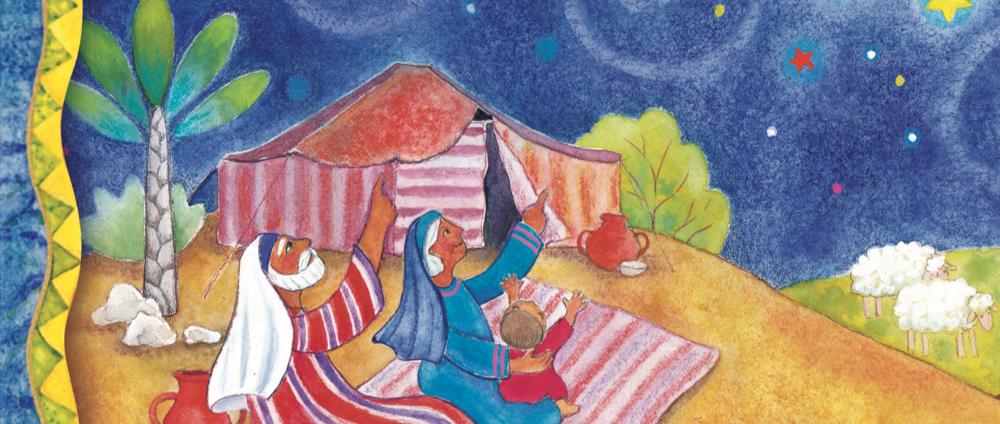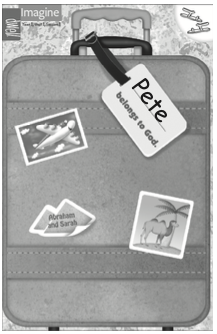
Abraham and Sarah
- Imagine Abraham and Sarah's long trip to a strange land.
- Realize and feel secure that, like Abraham and Sarah, we also belong to God.
- Give praise and thanks for belonging to God.
- Share the joy of belonging to God with others.
Session Outline
Leader Reflection
Most people who know anything about the Heidelberg Catechism know these poignant words at the very beginning: "My only comfort in life and death is that I belong . . . to my faithful Savior Jesus Christ." That comfort of belonging is the theme for this unit.
But the road to ultimate comfort in Jesus Christ began long before the events of the manger, the cross, and the empty tomb. It began even before this story of Abraham and Sarah. It began in the loving heart of the Creator God who made this world and all its creatures with us human beings as its crowning glory.
Even after we defaced God's good creation with our sinful rebellion, God did not let us go. God determined to redeem his world and restore us as his magnificent, image-bearing children. But with today's episode, the story of God's redeeming love takes a whole new direction. Beginning with just two people, and then a family, a tribe, a nation, and one very special person, his Son, Jesus Christ, God begins the long, long journey of reclaiming a world and a people that belongs to him.
To get into this story, it helps to begin with chapter 11 where the author sets the scene. It's like Google Earth, as the "camera" swoops in from far away in Ur with a list of names, and zeros in closer and closer till the whole screen is filled with just two people, Abram and Sarai.
As we look at their faces, we see lines of sadness. These two relatively old people have no children, an especially tragic circumstance in that day. What we're really seeing here is a dead end. From Adam and Eve slinking out of the garden, to the tragicomic bewilderment of Babel, here is what human effort has come to---barrenness.
Right there, in the bitter reality of human helplessness, God enters the scene. A call? A voice? Who knows what the experience was really like, but Abram heard its compelling invitation, "Go!" Amazingly, Abram and Sarai follow that stunning invitation to a new land, leaving everything behind. But it's more than a command or even an invitation. It's a promise: "I will bless you . . . and all peoples of the earth will be blessed through you."
God is on the move! And here's the wonderful thing: God determines to use the very creatures that rebelled to be his partners in blessing (redeeming) the world he made.
Belonging to God doesn't just mean that God finally does something to redeem us from sin and death. It means that we human beings will be his covenant partners in bringing it about. Belonging involves God's claim and God's call; his purpose includes our partnership.
What about their dead-end lives might have made Abram and Sarai open to God’s call, and why?
How did Abram and Sarai experience God’s call? How do you?
What do you think they felt like on the day of departure from Haran?
What did the blessing mean to Abram and Sarai, and what does it mean to you?
Remember that young children have little sense of time and history, so they won’t understand much of what makes you excited about God’s grand purposes. For them it’s the concrete, here and now reality of God’s call, of leaving home and traveling far away that will stir their imagination and faith.
Belonging to God means carrying God’s blessing in your heart. The idea of blessing may be foreign to the children, but everyone craves the experience of being blessed. As you sense the blessing of belonging to God, think of ways to convey it to the children—a word, a gesture that conveys the wonder of God’s love and belonging, and the specialness of God’s call.
If this story has connected with an experience of your own faith journey that’s appropriate for young children, prepare to tell it simply and from the heart.
Abram and Sarai receive new names later on; in this session we use the names Abraham and Sarah to avoid confusion.
Steps
Suitcase-shaped nametags printable page, one per child
Yarn cut in 18" (45 cm) lengths
Hole puncher
Stickers
Song: “God Is Always with Us”
Note: Print and prepare suitcase-shaped nametags (using cardstock if available) before class begins.
Today is a big day for you and the children in your group—they’re arriving with anticipation about what will happen and you’re arriving prepared to share and experience the wonder of God’s love with your group. That’s exciting! As you prepare for your time together, be sure to read the Bible story (Step 2) out loud several times so you’ll be able to maintain eye contact with your group while telling it.
Get off to a good start by warmly welcoming each child, smiling as you look into their eyes, and learning their names as soon as possible. Fill in the children’s names on their nametags as they arrive and, as time allows, invite kids to personalize their nametag by decorating it with markers or crayons and stickers. Remember to tell kids your name and make yourself a nametag too!
Gather your group around you. Explain that you are happy about two things today: that each of them has come to spend time with God, and that each of them belongs to God in a special way. To reinforce your comments and to help everyone learn names quickly, name each child as you say, “[Name] belongs to God.”
Point out that there is someone else in your small group—someone who will be there every time they are together. Can they guess who that is? Tell your kids that God is always with us and that means God is with you right now! Invite kids to stand and get ready to praise God as you sing a song about that together. Play “God Is Always with Us” and encourage your kids to move as described in the song—getting down low, jumping up high, shouting, turning around, spinning, and waving their hands. Be sure you join in on the fun too!
As the song ends, praise God with a round of applause together. Then invite kids to join you in taking a deep breath in . . . and out . . . to slow down your heart rates before you sit down and come to God in prayer together. During your prayer, mention how wonderful it is to know that God knows and loves each person in your group, and thank God for always being with each person in your group every day—at home, at school, at church and everywhere else they go.
Although it would be easy to teach this story as an example of how we should trust God, it’s much more than that. As Reformed Christians we believe this story is more about God’s call than it is about Abraham’s answer.
Suitcase packed with a Bible, clothes, dishes, blankets, towel, cups, bowl, and a pair of sandals
Show your group the suitcase you’ve brought. Take a few moments to talk together about suitcases and what they’re used for. Invite kids to guess what might be in your suitcase today. Open it so that your kids are able to see all the belongings—blankets, sandals, dishes, clothes—you’ve packed inside. Remove your Bible and close the suitcase, but don’t fasten it shut—you’ll want to do that later as you tell the story.
As you open your Bible to Genesis 12, explain to the children that you’ve brought it because it contains a story from God that you’d like to tell them—a story from God about a big move. Leave your open Bible on your lap or in front of you as you tell the story.
The story follows:
A long, long time ago—before there were cars or bikes, brick houses or apartment buildings—there lived an old man and an old woman. Their names were Abraham and Sarah, and they lived in a village of tents with their helpers, their helper’s children, and all their animals.
One day God came to tell Abraham two really important things.
The first thing God told Abraham was, “I want you to move far, far away. Leave your country, leave your land, leave your relatives, and go to the land that I will show you.”
How do you think Abraham felt when God told him to move far, far away to a place he’d never been before? (Pause for kids to share responses.)
If Abraham was feeling worried or scared about moving, he probably felt better when God told him the second important thing.
God said, “Abraham, you and Sarah belong to me. I’ve chosen you to be my people and I’m going to bless you and your family in wonderful ways. You’re going to have a big family—too many people to count—more than the stars in the night sky! People all over the world will know who you are and I’ll use you to help the whole world know that I am God.”
Wow! God promised to give Abraham many things and make him famous and use him to tell others about God!
I wonder how Abraham felt hearing that news. (Pause for responses.)
Abraham did what God asked him to do. (Pretend to organize the things in your suitcase and then fasten it shut as you describe how Abraham and Sarah prepared to leave.) He and his wife, Sarah, and all of their helpers folded their tents, rolled up their blankets, gathered their animals, packed their clothes, stacked their dishes, and got ready to move.
What would you make sure to pack if you were moving far, far away? (Pause for responses.)
Once all their things were packed and everyone was ready to go, Abraham and Sarah began the long trip to the place that God would show them. There were many hot and dusty days, but they knew they belonged to God and they trusted God to take care of them.
Do you know that you belong to God and that God loves you very much—as much as Abraham and Sarah? It’s true!
Finally, the tired travelers arrived in the new land God had chosen for them. God came to show Abraham around. (Look left, right, behind, and in front as you describe God showing Abraham the new land.) “Abraham,” God said, “Look both ways. Turn and look behind you. Now look waaaay out in front of you. I’m giving you everything your eye can see. It’s for you and your family forever! And that family is going to be BIG! I’m going to bless you with more children, grandchildren, great-grandchildren, and great-great-and-greater grandchildren than you can even count!
Abraham did look around. He thought about what God had said and about how wonderful it was to belong to God. Then he gathered some rocks, piled them up on top of each other to make a special altar, and praised God.
Everything happened just as God promised. God blessed Abraham, Abraham became famous, and the whole world was blessed through Abraham. Why? Because many, many, many years after God chose Abraham and Sarah to belong to him, a special child—Jesus, God’s own Son—was born in the huge family of people that came from them.
But before that could happen, Abraham and Sarah needed to have a child of their own—and I’ll tell you all about that next time!
Blankets/sheets
Clothing props: towels/scarves/neckties/vests
Stuffed animals, optional
Invite your kids to imagine that all of you joined Abraham and Sarah on their big move as you tell the story again together. Show kids the props you’ve brought. Suggest ideas for how you might arrange the room to tell the story (see below) but run with the ideas your group comes up with as much as possible so they can really experience the story at their level. Here are some ideas to explore with your kids as they set up the space:
- How could you spread out or arrange the sheets/blankets to create mountains and land? Should you cover up and include the room furniture in some way? Place a sheet on the floor for the hot, dusty desert trail that they traveled?
- Where might the starting place—Abraham and Sarah’s tent village—be? Where should you put the ending place—the new land?
- Invite kids to open up and empty the suitcase near the starting place—they’ll be packing it again during the story.
- Where should the stuffed animals go (if you brought some)? Who would like to be in charge of moving them?
- Which prop would you like to wear? Who could be Abraham? Sarah? Who are the helpers and the helper’s children?
- Is there anything in the room you could use to build an altar at the end of the story? (Books, perhaps?) Where do you think Abraham found the rocks he used for his altar— should you scatter around your altar pieces in the new land?
Once everyone is ready, it’s time to retell the story together. Invite everyone to pretend to “work” in their tent village as you retell the story, using the story from Step 2 as a guide. As you tell the story, help kids along as needed. Say,
Show how you imagine Abraham’s face might have looked when he heard God’s news. (Pause for responses.)
I wonder how the faces of Sarah and the helpers looked when Abraham told them what God had said. (Pause for responses.)
How do you think everyone felt when they had to say goodbye to their old places and friends and family before moving far away? (Pause for responses.)
Then walk along with them around the room for the long, tiring journey. Have Abraham show everyone the new land that God showed him by telling everyone to look left . . . then right . . . behind . . . and waaaaay out in front. Then have Abraham build an altar out of the “rocks.”
At the end of the story, invite your group to kneel around the altar and join you in a prayer:
Dear God, Abraham and Sarah and their helpers must have been so excited about all the ways you blessed them. We’re excited too because we know that we belong to you too, just like they did! Thank you for loving us and blessing us, Lord. Amen.
Invite kids to remove their props and help you set aside the storytelling materials. Point out that even though they are done acting out the story about Abraham, they are still in God’s story—because God is working in their lives every day.
Be sure to show and express with your group the joy that belonging to God gives to you! Look for an opportunity to tell your group about a time when you had to move or were uncertain about a new beginning and how you experienced God’s faithfulness in that situation.
Story symbol, session 1
Show and Share papers, session 1
Dear Family letters (printable page or email version), one per child
Note: Hang up the story symbol for this session before class begins. For ideas on how to display the story symbols in your room, see our Welcome to Dwell page.
Move to a table or to an area on the floor where everyone can do some drawing. Hold up today’s Show and Share paper. Explain that each person will get one today and a new one each week—their job is to show and share the story with someone else.
Tell your group that the suitcase on the paper reminds you of the today’s story. Ask if anyone can see something else in your room that’s also a reminder of the story. When a child points to the sandals story symbol hanging on your wall, explain that every week as you hear a different story about God, you’ll be adding another story symbol to the wall to remind them of that story. Wonder out loud how many story symbols you’ll have by the end of your year together!
Hand everyone a Show and Share paper. Read the names Abraham and Sarah and remind your group that they belong to God just like Abraham and Sarah. Invite kids to print their name on the “_________ Belongs to God” suitcase tag. Point out the story on the back of the Show and Share paper and invite them to share the story with someone else at home.
Open the “suitcases” and name some special belongings that Abraham and Sarah might have brought along on their moving adventure with God. Ask kids to name some special things they like to bring with them when you go places— pjs, a favorite stuffed animal or toy? Encourage them to draw a picture of one special thing they named in their suitcases. As children work, go around the room and talk to them about their drawings, reminding them that they are God’s special belongings!
Before kids leave, gather them around you and show them where Psalm 100 is found in your Bible. Say verses 1-3 for them and invite them to repeat the verses with you—joyfully! Explain that over the next few weeks they’ll be learning those words together. Next week they’ll learn a song with those words in it. Give each child a copy of the Memory Challenge (printable page) and invite everyone to be very quiet for a moment as they think of a good place to put their page when they get home so they’ll be able to look at it every day. Invite them to decorate it before putting it in that special place too!
Whisper a closing thought to each child as they head out the door: You belong to God!
Easy Extras
paper
crayons or pencils
scissors
Your kids will be going on a long journey today! Make footprints together while you’re waiting for everyone to arrive. Use crayons or pencils to trace around your feet onto a piece of paper. Cut out the shapes—offer to assist kids who need help cutting. Save them for your story drama (step 3) and scatter them on the floor to help map out Abraham’s trip!
baggies or containers with snacks (see below)
Enjoy a travelers’ snack together as you get to know each other better. Before class, prepare a small plastic baggie or container for each child with munchable items like Cheerios, chocolate chips, marshmallows, raisins, Goldfish crackers, and the like. Avoid nut products in case of allergies. Then hand out the snacks to enjoy as you talk about your favorite outdoor places to go.
large sheets of paper or mural paper prepared as described
precut paper shapes for kids to draw on
pencils or crayons, poster putty, glue
This activity can be substituted for Step 3: Living into the Story.
Imagine Abraham and Sarah’s moving adventure with God as you create a large mural together using mural paper or several sheets of paper attached together. Before class, draw a long, long road across the mural paper. Add some hills and mountains, but don’t color anything in. Hang the mural at eye level on the wall and walk your hand along it as you tell the Bible story the first time through. Then spend a few moments imagining the sights, sounds, and smells of the story events together and invite kids to help recreate the story with you. Give each child a precut paper shape (an oval or circle works well) on which to draw a person. Note: Drawing abilities vary widely with kids this age, so expect some very simple dashes, dots, and stick people from younger kids. While they work, prepare some paper “rocks” for the altar, adding wall putty to the back and setting them near the new land on the mural. As you retell the story, kids can move their people along the road, attaching them at the end and taking turns adding a “rock” to the altar.
Afterwards, invite kids to glue their people on the mural. Then hang your mural outside your room; encourage kids to show and tell about it!
none needed
Gather your group around you and invite kids to imagine that they are going on a long trip to a faraway place. Ask kids for destination ideas and select a location to use for your game. Encourage everyone to think of one thing they’d want to bring on the trip for sure. Explain that you’ll start the game by saying, “For our trip to [name of place], I’m going to pack sunglasses. The next person should say the same thing that you said and then add their own item. For example, “For our trip to [place], I’m going to pack sunglasses and a snack.” Continue around the circle, with each child repeating the entire list and adding a new item.
guest storyteller
clothing/props
rocks (either real rocks or an item from your room you can use to make an altar, such as books)
This activity can be incorporated into Step 3.
To allow for more movement in your story re-telling, ask an older couple from your congregation to take the roles of Abraham and Sarah, inviting the children to participate in their long trip to a new land. Follow them as Abraham leads the way and tells the story. Travel through the church and perhaps outside, reenacting the trip from Haran to Canaan. Use step 3 to guide your conversation throughout your journey. Remember to carry your, “rocks” with you or place them ahead of time at your end location. At the end of the story, have Abraham build an altar out of the “rocks,” and invite your group to kneel around it, and join you in the prayer at the end of step 3.
If you have time, bring a blanket to sit and eat your trail mix (See Easy Extra #2) with the older couple from your congregation. Ask them ahead of time if they would be willing to share about a time that they had to move or were uncertain about a new beginning; encouraging them to share how they experienced God’s faithfulness in that situation.
This activity was adapted from the Walk With Me curriculum previously available from Faith Alive.


